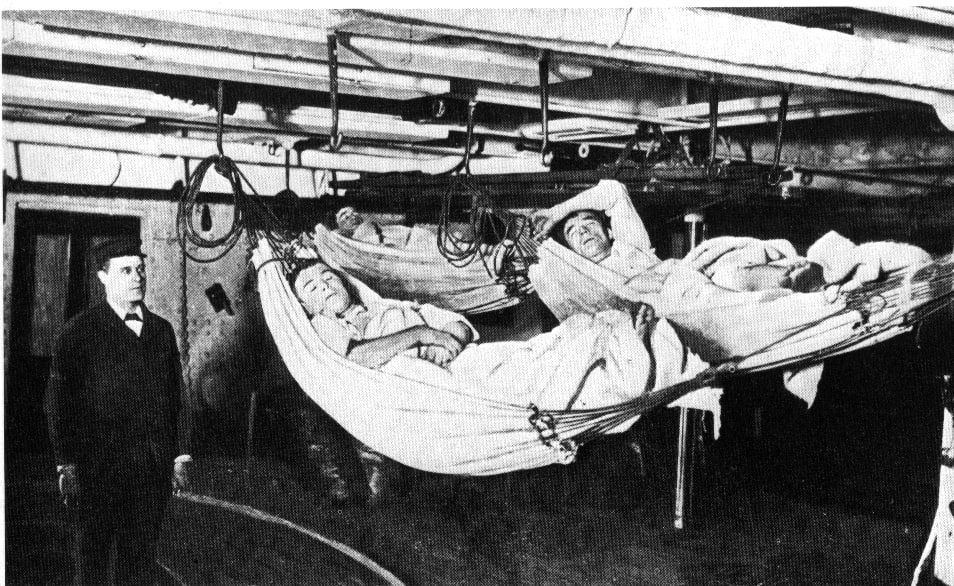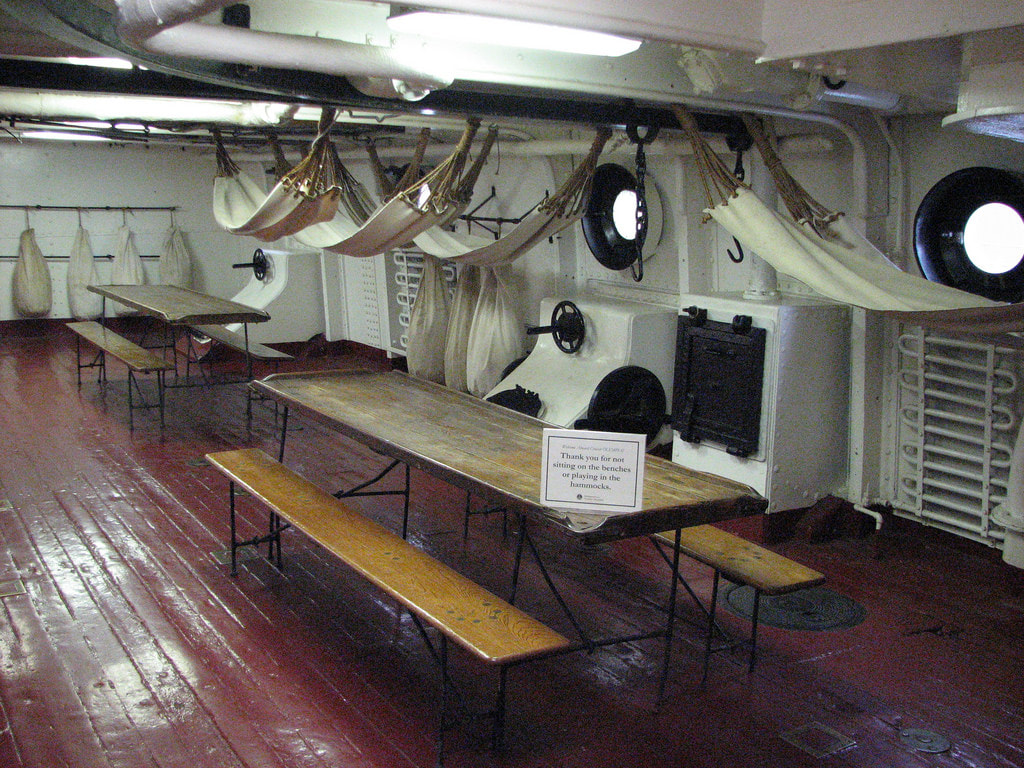|
Darwin war history
Catching a kip, Navy style17/1/2018 By Dr. Tom Lewis Dr. Tom Lewis OAM is a military historian. His latest work is The Empire Strikes South, the story of the Japanese aviators who died across the Top End in WWII. Sailors in hammocks, probably circa WWI or before. (Lewis Collection) For centuries, the sailor’s hammock was the usual method of getting sleep at sea for sailors. They were first used in Christopher Columbus’s ships when his sailors observed natives using them in the Caribbean Islands slung between trees. The name ‘hammock’ actually comes from the Caribbean word hamorca. Hammocks were slung fore and aft from the ship’s beams. During the day it was the custom to stow rolled-up hammocks on the weather deck packed into the lower rigging. Here they would get an airing, but also serve as protection against small arms fire. Hammocks could only be slung at certain times, no matter how long the user wanted to sleep, as the spaces in which they were slung also served as the messdeck. And if you didn’t responded quickly enough to “wakey wakey” you were unceremoniously tipped out of your hammock. The phrase ‘show a leg’ related to the women waiting in the harbours. These women were allowed in the Royal Navy (RN) as long as they declared they were seamen's wives. If the call ‘show a leg’ issued from within a hammock (and the leg in question was smooth) the duty rating left the occupier in peace. The use of hammocks continued in the Royal Australian Navy (RAN) through to the 1970s. Stoker John Day used them in the 1950s on corvettes but bunk beds began to replace slung arrangements. Lieutenant Errol Hunt, a sailor in the 60s, used a hammock on board HMAS Duchess until 1971. He remembers some of the problems. If you were “stepping” (going ashore) at 1600 you could not sling your hammock until after rounds at 1900. This meant sailors were often putting their hammocks up “under the influence.” Hammocks on board USS Olympia (USN) Errol also remembers an evening on board Anzac where his headrope broke and he fell a metre and a half onto the steel deck below. “It was my own fault,” he claims. “I saw it was frayed but I’d decided there were a few more sleeps left in it.”
In WWII corvettes hammocks were stored in a seven foot square bin on each side of the accommodation compartments. Ship’s company members were not allowed to sling them until the second dog watch, and hammocks were struck at 0600 the next morning for dawn action stations. John Day remembers that there was no sleeping past that time no matter what watch you’d kept. Ships in combat areas went to dusk and dawn action stations with all personnel. Imagine trying to sleep with around 20 people fitted into the space of an average suburban bedroom. WWII ships were overcrowded as extra ship’s company members were added as radar and more AA guns were positioned. The sailors’ discomfort was increased by a lack of ventilation. The whole vessel was darkened with scuttle covers every night to stop light leakage. Before WWII officers’ cabins featured “cots”, wooden beds slung from the bulkhead, allowing the user the privilege of sleeping on a hard surface to support a straight spine. A hammock was also useful as a shroud when one was being buried at sea. Tradition has it that the last stitch of the hammock being sewn up was through the departed’s nose, just to ensure he was actually dead. wwII history
0 Comments
Leave a Reply.Darwin Military Museum
|
How to Contact and find the Darwin Military Museum
Click on Address: LOT 5434 Alec Fong Lim Dr, East Point NT 0820
|
|
Check out Facebook!
|
Find out more |
Darwin Military Museum
OPENING TIMES & TICKETS
Please note we are closed on the following days:
Sun 24th - Tues 26th Dec 23 (inclusive)
Sun 31st Dec - Mon 1st Jan 24 (inclusive)
Closed: Good Friday, Easter Sunday, Christmas, Boxing and New Years days.
- Please note we will be open from 10 - 3 on Easter Saturday
OPENING TIMES 7 days a Week
(refer above for exceptions)
9.30am - 4pm Monday - Saturday
10.00am - 3pm Sunday and public holidays
We recommend you allow at least 1.5hrs for your visit.
ADMISSION FEES & ONLINE TICKETS
(Proof of id/concession required for Pensioner (65+), Uni/TAFE student, Veteran, Serving Military Member and Disability/Carer)
ADULTS (16 years +): $20.00
CHILDREN (5 - 15 years): $10.00
CHILDREN (under 5 years): FREE
FAMILY PASS (2 ADULTS, 3 CHILDREN U16): $45.00
PENSIONER (65 years +): $15.00
UNIVERSITY/TAFE STUDENT: $15.00
COMPANION CARD HOLDER AND PERSON WITH A DISABILITY: $20.00
VETERANS: $15.00
SERVING MILITARY MEMBERS: $15.00
SCHOOL GROUPS: Northern Territory students on excursion Students 16 years and under during school hours: $5.00 per student. Students must be supervised at all times. 1 adult per 10 students: $20.00
SCHOOL GROUPS: Non-NT students on excursion
Students 16 years and under during school hours: $10.00 per student. Students must be supervised at all times.
1 adult per 10 students: $20.00
Please note we are closed on the following days:
Sun 24th - Tues 26th Dec (inclusive)
Sun 31st Dec - Mon 1st Jan (inclusive)
For hotels nearby, check with HotelsCombined


 RSS Feed
RSS Feed





